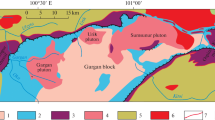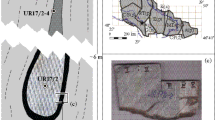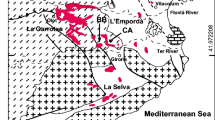Abstract
Sulfide-bearing polymineralic inclusions in mantle-derived chromium pyrope garnets of lherzolite paragenesis from lamprophyres of the Chompolo field (Aldan shield, southern Siberian craton) have been studied. The inclusions are composed of either only sulfides or sulfides in association with other minerals (carbonates, silicates, oxides, etc.). The sulfide part of the inclusions is represented by up to four minerals. Among the sulfides, minerals rich in Cu and Ni have been found, whereas Fe sulfides (pyrrhotite, troilite) are absent. This distinguishes the inclusions studied from the majority of sulfide inclusions in mantle minerals and diamonds, as well as in mantle xenoliths from kimberlites. The formation of polymineralic inclusions in chromium garnets of the Chompolo field is attributed to the effect of a carbonate–silicate metasomatic melt/fluid on mantle peridotites, as evidenced by the mineral suite associated with the sulfides. The research results indicate significant differences in the nature of metasomatic processes that occurred in the lithospheric mantle of the southern and central parts of the Siberian craton.
Similar content being viewed by others
Avoid common mistakes on your manuscript.
Sulfide inclusions in minerals of mantle origin are widely used as a source of information on deep processes in the Earth’s mantle. Traditionally, the objects of study are mantle xenoliths and xenocrystals from kimberlites. Mantle minerals from other abyssal rocks such as lamproites and lamprophyres have received much less attention.
This communication presents the results of a study of a collection of xenocrystals of mantle Cr-bearing pyrope garnet from the Aldanskaya dike and the Ogonek pipe of the Chompolo lamprophyre field located in the southern part of the Siberian craton (Aldan shield) [1, 2]. Sulfides were found in only 16 out of more than 600 garnet grains studied, which were 2–4 mm in size, containing mineral inclusions (Table 1). Most of the inclusions in the garnets are titanium and chromium oxide minerals (rutile, picroilmenite, Cr-spinel, and crichtonite group minerals). In most cases, inclusions consist of only 1–3 phases, although more complex polymineral segregations are also noted.
The chemical composition of garnets and clinopyroxenes was determined by means of a Jeol JXA-8100 microprobe according to the standard procedure. Elemental mapping of sulfides and analysis of the chemical composition of the inclusions were performed on a SEM (Tescan MIRA 3 LMU equipped with an INCA Energy 450 EDS system). Confocal Raman spectroscopy (RS) was also used to identify mineral inclusions. Analytical studies were carried out at the Analytical Center for multi-elemental and isotope research at the Sobolev Institute of Geology and Mineralogy, Siberian Branch, Russian Academy of Sciences. Determination of rare and trace elements in garnets was carried out by means of the LA–ICP–MS method (Agilent 7900cs equipped with a NewWave 193 nm laser sampler) at the National Key Center GEMOC/CCFS at Macquarie University (Sydney, Australia). In this work, we used data on the content of Ni; the full results of LA–ICP–MS studies will be published elsewhere.
According to the ratio of CaO and Cr2O3, the pyropes studied belong to the lherzolite paragenesis [3, 4] (Fig. 1a). Variations Mg# [100 × Mg/(Mg + Fe)] and Ca# [100 × Ca/(Ca + Mg + Fe + Mn)] are within 74.6–81.0 and 10.9–15.3, respectively. The TiO2 concentration does not exceed 0.24 wt %.
(а) Variations of CaO and Cr2O3 in peridotite pyropes with sulfide inclusions (1), imposed on the compositions of garnets from the heavy fraction of the Chompolo field lamprophyres, n = 1343 (2). Mantle parageneses according to [3]: HD, harzburgite-dunite; L, lherzolite; W, wehrlite. The field bounded by the dotted line is the lherzolite paragenesis according to [4]. (b) Estimates of PT-parameters for pyropes with sulfide inclusions from the Chompolo field lamprophyres (figure modified from [2]). Black diamonds are estimates according to chromium diopside inclusions. The segments show the temperature estimation intervals for pyropes with sulfide inclusions (T(NI)SU) and for a more representative sample of pyropes from the Aldanskaya dike and Ogonek pipe (T(NI)), determined using a Ni-in-Gar monomineral thermometer [6]. Dashed lines show model geotherms for different surface heat flux [7]. The gray field shows the PT-estimates from [2].
The estimated values of temperature and pressure for pyropes s115, s2, s207, and 1n11 containing chrome diopside inclusions (Table 1), performed by means of a mineral clinopyroxene thermobarometer [5], are 690–790°C and 2.9–3.5 GPa. These data are consistent with earlier estimates [2] (Fig. 1b). The temperature range obtained by means of a thermometer [6] for pyropes with sulfide inclusions (Table 1) is 670–760°C. For a more representative sample of pyropes from the Aldanskaya dike and the Ogonek pipe of the Chompolo field, the temperature values have a wider range of 640–910°C (Fig. 1b).
No cracks connecting inclusions with the grain surface were observed in the pyropes studied. Therefore, the mantle genesis of the mineral phases studied is assumed. The mantle genesis is also evidenced by the high contents of Cr2O3 (up to 1 wt %) in phlogopite and oxide minerals (e.g., up to 7.2 wt % C2O3 in rutile) from inclusions [8], as well as estimates of the temperatures and pressures for inclusions of chrome diopside.
The mineral set of inclusions can be divided into two groups: the first group includes inclusions represented only by sulfides (Table 1, Fig. 2a); the second group has a more complex phase composition and comprises silicates, carbonates, oxides, apatite, and graphite (Table 1, Fig. 2b). At the same time, the sulfide part of the second group inclusions is always isolated from other minerals; no traces of reaction relationships were established (Fig. 2b; also see Fig. 2 in [9]). Sulfide inclusions have a round, irregular, or faceted shape and size in the range of 5–200 µm. They are usually surrounded by radial cracks. The formation of such cracks is conventionally associated with a different degree of expansion of garnet and the mineral inclusion as a result of decompression during the ascent of the transporting magma [2], which also testifies in favor of the mantle origin of the inclusions.
Mineral phase relationships (BSE image) and maps of element distribution (Fe, Ni, Cu, S) in the polymineral inclusions of pyropes s1 and sx2 from the Aldanskaya dike. Symbols are explained in Table 1.
Sulfide inclusions, as a rule, are heterogeneous and consist of several minerals, among which pentlandite, chalcopyrite, bornite solid solution, mineral with the assumed formula CuFe2S4, monosulfide solid solution (MSS), heazlewoodite, and the (Fe,Ni,Cu)1 ± xS compound are recognized (Table 1; Fig. 2). Pentlandite (FeNi)9S8 is the most abundant phase and usually fills the bulk of the inclusion. Chalcopyrite (CuFeS2) is located in the outer part of inclusions or forms rims around it. A bornite solid solution (Cu5 ± xFe1 ± xS4 ± y) and heazlewoodite (Ni3S2) were observed together with pentlandite and MSS (Table 1).
Fe–Cu–bearing sulfide with the calculated formula (Cu,Ni)1.10–0.93(Fe,Co)1.90–2.07S4 was found in samples s1, s9, and s38 in association with pentlandite and chalcopyrite. The predominance of Fe (33.1–34.9 wt %) over Cu (12.0–16.0 wt %) was established. This phase contains Ni (2.4–8.3 wt %) and Co (1.4–2.2 wt %) impurities. The Me/S ratio varies in the range 0.69–0.75, and the S content is 42.0–44.2 wt %. A similar sulfide with the formula CuFe2S4 was described in the ores of the Lovozero deposit on the Kola Peninsula [10].
MSS is characterized by the ratio Ni/(Ni + Fe) = 0.40–0.60 with Ni contents in the range of 21–36 wt % and the Me/S ratio in the range 0.80–0.93.
Compound (Fe, Ni, Cu)1 ± xS is characterized by a high Ni (50.0–61.9 wt %), moderate Fe (2.0–11.7 wt %), and low Cu (up to 3.4 wt %) content, high ratio Ni/(Ni + Fe) = 0.80–0.97, and Me/S ratio of 0.96–1.06.
The bulk compositions of the sulfide component of inclusions (s1, s2, s9, s291, s38) vary in the Ni and Fe content in the range of 26.2–37.7 wt % and 23.5–32.1 wt %, respectively, and a Cu content up to 7.4 wt % in the relatively Ni-rich varieties (Fig. 3).
Composition of the sulfides studied in the diagrams Cu–Fe–S and Fe– (Ni + Co)-S (wt %). Avc, bulk composition of the inclusions studied; Dia, composition of the sulfide inclusions in diamonds; P, peridotite; Е, eclogite paragenesis [11].
A mineral association with similar high contents of Cu and Ni in sulfides was described in spinel harzburgite and dunite xenoliths in alkaline rocks of the Kerguelen archipelago [12]. These xenoliths show traces of the metasomatic effect of an alkaline carbonate-bearing melt, manifested in the form of veinlets and interstitial precipitates of carbonates (calcite, dolomite, magnesite), amphibole, phlogopite, chromite, ilmenite, rutile, apatite, etc. The authors of [12] suggested that such a melt can efficiently transfer Cu, Ni, and S in dissolved form and decompose into immiscible sulfide and carbonate melts that can migrate through the peridotite matrix independently of each other. Experiments at high pressures have shown that carbonate-containing melts (carbonate or silicate–carbonate) are effective transporters of sulfur, the solubility of which in such melts increases in oxidized conditions and depends on the temperature and composition [13, 14]. Thus, an alternative variant of sulfide formation can be their crystallization from a metasomatizing carbonate-containing melt because of a decrease in temperature or a shift of redox conditions to more reduced ones, as evidenced by the presence of graphite inclusions in the pyrope xenocrystals studied (Table 1) [2].
We assume that the formation of sulfide-bearing polymineral inclusions in the pyropes studied is associated with the impact of the carbonate-bearing metasomatic melt/fluid on the lithospheric mantle peridotites. This is evidenced by the minerals accompanying sulfides, which are rich in volatile and incompatible elements (Table 1), and confirmed by earlier studies of the polymineral inclusions in chromium pyropes from kimberlites and lamprophyres of the Siberian craton [2, 9, 15]. Unfortunately, the lack of experimental data at high pressures on phase relations in the Cu-rich region of the Fe–Ni–Cu–S system corresponding to the bulk composition of the sulfide inclusions studied does not allow us to establish reliably whether the initial sulfide material of the inclusions was a melt.
High Cu concentrations and the absence of Fe-rich minerals (pyrrhotite and troilite) distinguish the mantle sulfide associations of the Chompolo field from most inclusions in mantle minerals and diamonds, as well as sulfides of mantle xenoliths in kimberlites of the Siberian craton [11] (Fig. 3). This indicates significant differences in the nature of the metasomatic processes that took place in the lithospheric mantle of the southern and central parts of the Siberian Craton.
REFERENCES
E. I. Nikolenko, K. V. Lobov, A. M. Agashev, N. S. Tychkov, M. V. Chervyakovskaya, I. S. Sharygin, and A. M. Nikolenko, Minerals 10 (10), 886 (2020).
E. I. Nikolenko, I. S. Sharygin, T. A. Alifirova, A. V. Korsakov, P. S. Zelenovskiy, and V. Y. Shur, J. Raman Spectrosc. 48, 1597–1605 (2017).
N. V. Sobolev, Y. G. Lavrent’ev, N. P. Pokhilenko, and L. V. Usova, Contrib. Mineral. Petrol. 40, 39–52 (1973).
H. S. Grütter, J. J. Gurney, A. H. Menzies, and F. Winter, Lithos 77, 841–857 (2004).
P. Nimis and W. R. Taylor, Contrib. Mineral. Petrol. 139 (5), 541–554 (2000).
C. G. Ryan, W. L. Griffin, and N. J. Pearson, J. Geophys. Res.: Solid Earth 101, 5611–5625 (1996).
D. Hasterok and D. S. Chapman, Earth Planet. Sci. Lett. 307 (1–2), 59–70 (2011).
V. G. Malkovets, D. I. Rezvukhin, E. A. Belousova, W. L. Griffin, I. S. Sharygin, I. G. Tretiakova, and A. M. Logvinova, Lithos 265, 304–311 (2016).
T. A. Alifirova, D. I. Rezvukhin, E. I. Nikolenko, L. N. Pokhilenko, P. S. Zelenovskiy, I. S. Sharygin, A. V. Korsakov, and V. Shur, J. Raman Spectrosc. 51, 1493–1512 (2020).
D. A. Orsoev, S. V. Kanakin, Ya. A. Pakhomovskii, Z. F. Ushchapovskaya, and L. Z. Reznitskii, Zap. Ros. Mineral. O-va 144 (3), 70–81 (2015).
E. S. Efimova, N. V. Sobolev, and L. N. Pospelova, Zap. Vses. Mineral. O-va 112 (3), 300–310 (1983).
J. P. Lorand, G. Delpech, M. Gregoire, B. Moine, S. Y. O’Reilly, and J. Y. Cottin, Chem. Geol. 208 (1-4), 195–215 (2004).
A. B. Woodland, A. V. Girnis, V. K. Bulatov, G. P. Brey, and H. E. Höfer, Chem. Geol. 505, 12–22 (2019).
P. Chowdhury and R. Dasgupta, Geochim. Cosmochim. Acta 269, 376–397 (2020).
D. I. Rezvukhin, V. G. Malkovets, I. S. Sharygin, I. G. Tretiakova, W. L. Griffin, and S. Y. O’Reilly, Lithos 308, 181–195 (2018).
Funding
Analytical studies were supported by the Russian Science Foundation, project no. 18-77-10062 (SEM, EPMA, RS) and no. 18-17-00249 (LA-ICP-MS). Field work and sampling were supported by a State Assignment of the Sobolev Institute of Geology and Mineralogy, Siberian Branch, Russian Academy of Sciences. Handpicking of garnet samples with mineral inclusions was supported by the President of the Russian Federation, grant no. МК-971.2020.5.
Author information
Authors and Affiliations
Corresponding author
Additional information
Translated by M.S. Nickolsky
Supplementary Information
Rights and permissions
About this article
Cite this article
Nikolenko, E.I., Sharygin, I.S., Rezvukhin, D.I. et al. Sulfide-Bearing Polymineralic Inclusions in Mantle-Derived Garnets from Lamprophyres of the Chompolo Field (Central Aldan, Siberian Craton). Dokl. Earth Sc. 497, 300–304 (2021). https://doi.org/10.1134/S1028334X21040115
Received:
Revised:
Accepted:
Published:
Issue Date:
DOI: https://doi.org/10.1134/S1028334X21040115







